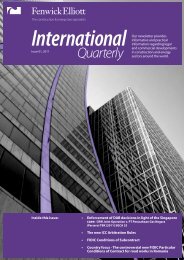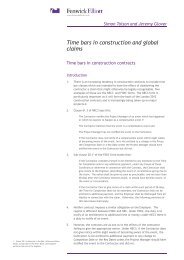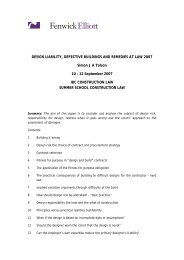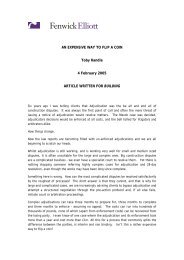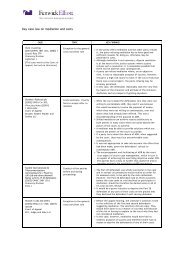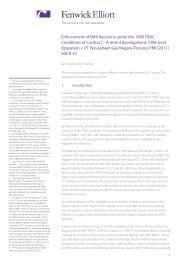Standard forms: JCT 2005, NEC3 and the Virtual ... - Fenwick Elliott
Standard forms: JCT 2005, NEC3 and the Virtual ... - Fenwick Elliott
Standard forms: JCT 2005, NEC3 and the Virtual ... - Fenwick Elliott
Create successful ePaper yourself
Turn your PDF publications into a flip-book with our unique Google optimized e-Paper software.
<strong>St<strong>and</strong>ard</strong> <strong>forms</strong>: <strong>JCT</strong> <strong>2005</strong>, <strong>NEC3</strong> <strong>and</strong> <strong>the</strong> <strong>Virtual</strong> Contract<br />
www.fenwickelliott.co.uk<br />
However, <strong>the</strong> implications of adjudication pursuant to <strong>the</strong> Housing Grants, Construction<br />
<strong>and</strong> Regeneration Act 1996 cannot be ignored. Any of <strong>the</strong> parties to <strong>the</strong> multi-party<br />
PPC2000, provided that <strong>the</strong> project is covered by <strong>the</strong> Act, will be able to call upon an<br />
adjudicator “at any time”. While <strong>the</strong> adjudication process has been shown to be extremely<br />
effective within <strong>the</strong> construction industry, <strong>the</strong> ability for any party to call upon an<br />
adjudicator at any time does not assist <strong>the</strong> partnering based approach.<br />
The <strong>JCT</strong> constructing excellence contract<br />
The <strong>JCT</strong> Constructing Excellence Contract 2006 is based on <strong>the</strong> BE Collaborative Contract. 27<br />
There are 2 versions; one is a bilateral agreement 28 for use between <strong>the</strong> employer <strong>and</strong><br />
supplier while <strong>the</strong> o<strong>the</strong>r is a multiparty agreement. 29 In addition, a <strong>JCT</strong> CE Guide has been<br />
produced.<br />
The overriding principle in Section 2 of <strong>the</strong> <strong>JCT</strong> CE is collaboration. The parties are:<br />
“To work toge<strong>the</strong>r with each o<strong>the</strong>r <strong>and</strong> with all o<strong>the</strong>r Project Participants in a cooperative<br />
<strong>and</strong> collaborative manner in good faith <strong>and</strong> in <strong>the</strong> spirit of mutual trust<br />
<strong>and</strong> respect.” 30<br />
The rest of <strong>the</strong> terms are to be read in <strong>the</strong> light of that overriding principle, <strong>and</strong> <strong>the</strong>refore <strong>the</strong><br />
terms, <strong>and</strong> possibly <strong>the</strong> conduct of <strong>the</strong> parties is to be read against <strong>the</strong> obligation on <strong>the</strong><br />
parties to co-operate <strong>and</strong> collaborate in good faith. An open book accounting procedure<br />
has been adopted. The parties are supposed to reach a consensus on how variations to<br />
<strong>the</strong> scope of work are to be incorporated. If <strong>the</strong> parties cannot reach a consensus <strong>the</strong>n <strong>the</strong><br />
contract provides a dispute escalation mechanism for resolving <strong>the</strong> matter.<br />
In addition to <strong>the</strong> contract <strong>the</strong> parties are expected to develop a “project protocol”. This<br />
sets out what <strong>the</strong> parties hope to gain from <strong>the</strong>ir collaboration <strong>and</strong> how those goals might<br />
be achieved. The protocol is not intended to be contractually binding, <strong>and</strong> <strong>the</strong>refore this<br />
aspect can be considered more akin to <strong>the</strong> non-binding charters such as NEC Option X12<br />
<strong>and</strong> <strong>the</strong> <strong>JCT</strong> Partnering Charter <strong>and</strong> more recently <strong>the</strong> <strong>JCT</strong> <strong>2005</strong> Framework Agreement<br />
(Non-binding).<br />
27 The <strong>JCT</strong> CE is based on <strong>the</strong> BE Collaborative<br />
Contract, which was initially developed by<br />
<strong>the</strong> Reading Construction Forum. The BE Contract<br />
was limited to <strong>the</strong> design <strong>and</strong> construction<br />
phase like most st<strong>and</strong>ard <strong>forms</strong>, <strong>and</strong> did not<br />
deal with <strong>the</strong> operation or performance of <strong>the</strong><br />
building once completion has been achieved.<br />
It was a two party contract not a multi party<br />
contract like <strong>the</strong> PPC2000. The BE Collaborative<br />
Contract comprises a set of st<strong>and</strong>ard conditions<br />
<strong>and</strong> a purchase order. One set of conditions<br />
<strong>and</strong> a purchase order were produced for a party<br />
that supplies <strong>and</strong> constructs, <strong>and</strong> <strong>the</strong> o<strong>the</strong>r for a<br />
party that merely acts as a supplier.<br />
28 <strong>JCT</strong> Constructing Excellence Contract “<strong>JCT</strong><br />
CE”.<br />
29 <strong>JCT</strong> Constructing Excellence Contract<br />
Project Team Agreement “<strong>JCT</strong> CE/P”.<br />
30 Clause 2.1.<br />
31 Clause 5.2<br />
32 Clause 5.3<br />
A fur<strong>the</strong>r interesting aspect of this contract is <strong>the</strong> preparation of a “Risks Register”. 31<br />
The contract <strong>the</strong>refore anticipates that <strong>the</strong> parties will analyse <strong>and</strong> identify risks. There<br />
is, <strong>the</strong>refore, a pro-active approach to risk management requiring identification of risks<br />
which might affect not just <strong>the</strong> delivery but also <strong>the</strong> performance of <strong>the</strong> works or <strong>the</strong><br />
parties to <strong>the</strong> contract.<br />
Once <strong>the</strong> risks have been identified <strong>the</strong> parties need to <strong>the</strong>n produce a “Risk Allocation<br />
Schedule” identifying <strong>the</strong> time <strong>and</strong> financial consequences of those risks. 32 In o<strong>the</strong>r words,<br />
<strong>the</strong> parties are <strong>the</strong>n identifying who bears <strong>the</strong> time <strong>and</strong> cost risk of any particular item<br />
on <strong>the</strong> Risks Allocation Schedule. This approach has become more common on larger<br />
projects, but should be encouraged on a much wider range of projects. A detailed risk<br />
allocation schedule produced for a specific project goes a long way towards avoiding<br />
disputes about who might be liable or any particular issue.<br />
23



